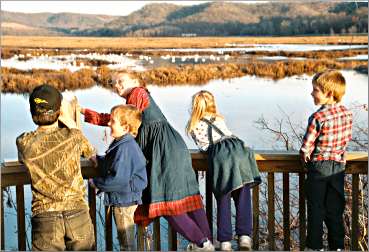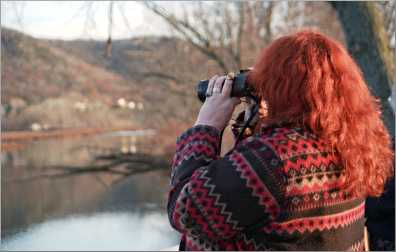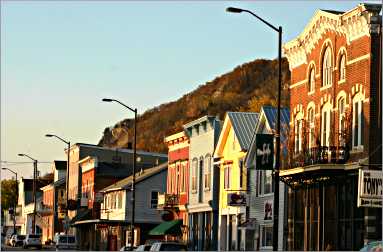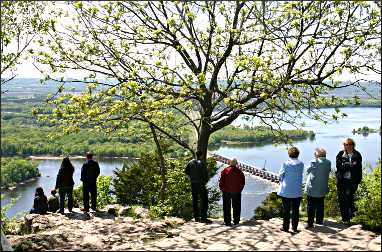Wings over the Mississippi
Tundra-swan watchers have a honkin' good time during the November migration.

© Beth Gauper
In the sloughs of the Upper Mississippi, birds of a feather flock together.
Bird-watchers, especially. On chilly days in late fall, they crowd onto wooden platforms to watch tundra swans paddling around sloughs of the Mississippi River.
This big bird needs a lot of fuel for its flight from the Arctic Circle to the marshes of Chesapeake Bay.
So when ponds in southern Canada and North Dakota start to ice over in October, the swans fly down to feast on arrowhead tubers and wild celery along the Mississippi before continuing east.
Once, as many as 6,000 tundra swans came to Rieck's Lake in Alma, Wis. But river sediment filled the slough, accelerated by floods, and their favorite tubers largely were replaced by burr reeds.
Now, many swan-watchers go to the Shady Maple Overlook in La Crosse and the Brownsville Overlook in Minnesota, where naturalists from the Upper Mississippi River National Wildlife Refuge help visitors spot birds on weekends through the third week of November.
Wherever the swans are, photographers have a field day. When I arrived in Alma one afternoon in November, Murnice Kuesel of nearby Arkansaw had been out since 6:45 a.m. with his bazooka-sized lens, photographing and watching the antics of more than 400 swans.
"You've got the family thing, the mom and dad and kids," he said. "A while ago, there were a couple of kids who had their necks around each other, fighting. Finally, the mom and dad had to swim over and break them up. Typical."
Swans also create a ruckus if another family infringes on its feeding area or a lone swan tries to join their family.
By 4:30 p.m., the swans were stirring, raising heads that had been tucked under wings and calling to each other in long hoots. Suddenly, there was a loud commotion, with wings flapping and necks pumping furiously.
All was quiet for a minute, and then another quarrel flared nearby. Soon raucous honking filled the valley and swans began to head for open water, where they spend the night.

© Beth Gauper
The swans sounded like the world's biggest kazoo band when they returned just after daybreak, in a cacophony of honks, clucks, trills and squawks.
By 7:30 a.m., the sky was filled with swans coming in for a landing, skidding on the water until they sank, long necks popping back up like periscopes.
Murnice Kuesel already was on the platform and showed me K744, a swan banded in 1992 and thought to have flown more than 100,000 miles in her lifetime.
"Did you hear that when they get a good tail wind, they can fly 100 miles an hour?" he asked. "One of the volunteers said one took off from here and in a day or so was in Chesapeake Bay."
Looking through the scope, I spotted X079 and then H158, which volunteer DD Starr of Buffalo City added to her chalked list when she arrived with her husband, Bob.
"Help yourselves to our scopes and see our gorgeous birds," she said. A family of four flew toward us, circled and landed in a perfect line, swimming side by side and turning into the channel in tight formation.
"Look at that, two parents and two cygnets," Starr said. "See, the young ones have orange bills. I think it's remarkable: They're just born around June, and they're making a 4,000-mile trip with their parents."
Red-tailed hawks, teals, shovelers, coots, canvasback ducks and muskrats also frequent the marsh. Ron Laack of Plainview, Minn., had set up his own scope and showed me two bald eagles sitting in a tree across the lake.
In the tree behind the deck, he pointed out an oriole nest, hanging from the top branch like a snood. Then he and Gary Krogman of Eau Claire, Wis., passed around their photos; both men are photographers and who also have worked with the National Eagle Center in Wabasha.
"You want to show what you saw," Laack said.
Krogman came to Alma to photograph the swans and had been volunteering on the deck ever since.
"The best thing to see is a swan fall, when they come in ahead of a front from North Dakota," he said. "They swarm this whole area and just drop in. They're like pearls up in the blue sky, strings and strings of them. It's just an amazing thing; I've seen it twice in eight years."

© Beth Gauper
Bald eagles also are on the move in November, as well as pelicans and hundreds of thousands of geese and ducks.
In October, the temperature starts to drop up north. On the ponds of Saskatchewan and North Dakota, the swans eat and wait for a cold wind from the northwest. When it starts to blow, they'll hop on board and let it push them across the plains.
Next stop: the sloughs of the Mississippi.
Trip Tips: Swan-watching around Alma, La Crosse and Brownsville
Getting there: Alma (pronounced EL-ma by locals) is an hour upriver from La Crosse. Rieck's Lake is just north of town on I-35.
The U.S. Fish & Wildlife Service recommends three places to view tundra swans. Refuge staff and volunteers often staff them from 10 a.m. to 2 p.m. the first three weekends in November.
Weaver Bottoms is south of Kellogg, Minn., in the hamlet of Weaver. Parking is available on a service road on the west side of Highway 61 at 116th Avenue (mile marker 45), about 1.75 miles southeast of the Highway 61/Highway 74 junction.
Shady Maple Overlook is on Wisconsin 35, one mile south of the entrance to Goose Island County Park south of La Crosse.
The Brownsville Overlook is three miles south of Brownsville off Minnesota 26, 18 miles south of La Crosse/La Crescent, Minn., not far from the Iowa border.
There are another two viewing decks in the seven miles between Brownsville and Reno on Minnesota 26.
When to go: The most activity is early in the morning and in late afternoon, when the sun is setting behind the deck, producing beautiful lighting for photographers, and the birds are flying overhead, heading for the river bottoms.
Dress as warmly as possible; if you're taking photos, bring mittens or gloves with open fingertips.
Rangers at the Upper Mississippi River National Wildlife and Fish Refuge post recent wildlife sightings.
Excursions: The Friends of the Refuge suggest a self-guided swan watch tour.
The National Eagle Center in Wabasha offers a swan-watching field trip in mid-November, $60. Reserve as early as possible.
Viewing: For updates on the migration and advice about the best places to see tundra swans and other birds, check the Fall Flight Surveys issued weekly by the Upper Mississippi River National Wildlife and Fish Refuge.
For swans around Alma, call Wings Over Alma at 608-685-3303.
There will be swans at Rieck's (pronounced Rick's) Lake, but viewing may be better on the other side of Rieck's Lake: From Wisconsin 35, just north of the slough, take County Road I to Badland Road and view swans from there.
Or take Wisconsin 37 along the Buffalo River; the road passes several sloughs, and many swans congregate at Tell Lake.

© Beth Gauper
Eagle-watching: Eagles migrate south along with swans, and Alma's lock and dam and the observation deck at Wings Over Alma on Main Street are good places to see them. Many eagles stay for the winter and can be seen on the ice below the dam; at times, more than 100 at a time.
For more about eagle-watching in winter, see Where eagles land.
For excursions around Alma, see Open sesame on the sloughs.
In Wabasha, the National Eagle Center is a natural stop for bird-watchers. Three bald eagles and a golden eagle are in residence.
For more, see All eyes on Wabasha.
Accommodations: Light sleepers should avoid staying close to the rail line, on which trains thunder by all night.
The Hotel de Ville in Alma is on Main Street and has five suites. Also on Main Street, the five-bedroom Blue Door Inn is a vacation rental.
The Tritsch House B&B is closer to the bluffs and has four rooms, three with double Jacuzzis, good for warming up after early-morning bird-watching.
Dining: The Alma Hotel Bar & Restaurant, serves a traditional menu of fried fish, chicken, steak and burgers.